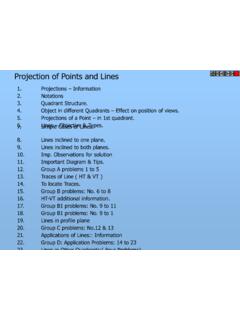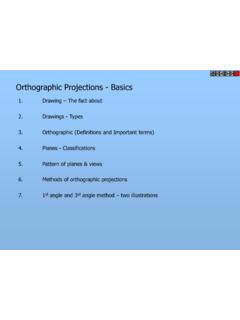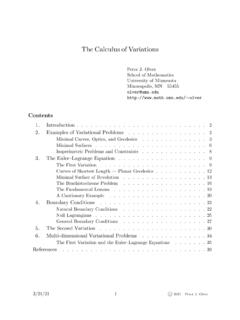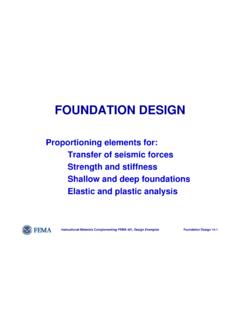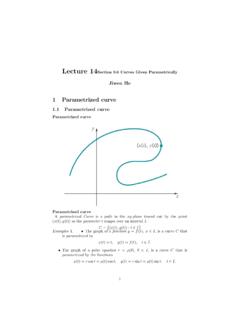Transcription of Engineering Curves I
1 Engineering Curves I 1. Classification 2. Conic sections - explanation 3. Common Definition 4. Ellipse ( six methods of construction) 5. Parabola ( Three methods of construction) 6. Hyperbola ( Three methods of construction ) 7. Methods of drawing Tangents & Normals ( four cases) Engineering Curves II 1. Classification 2. Definitions 3. Involutes - (five cases) 4. Cycloid 5. Trochoids (Superior and Inferior) 6. Epic cycloid and Hypo - cycloid 7. spiral (Two cases) 8. Helix on cylinder & on cone 9. Methods of drawing Tangents and Normals (Three cases) Engineering Curves Part- I {Conic Sections} ELLIPSE Circle Method Method Method of Circle Method Metho Locus Method (Directrix focus) HYPERBOLA Hyperbola (coordinates given) 2 Rectangular Hyperbola (P-V diagram - Equation given) Locus Method (Directrix focus) PARABOLA Method 2 Method of Tangents ( Triangle Method) Locus Method (Directrix focus) Methods of Drawing Tangents & Normals To These Curves .
2 CONIC SECTIONS ELLIPSE, PARABOLA AND HYPERBOLA ARE CALLED CONIC SECTIONS BECAUSE THESE Curves APPEAR ON THE SURFACE OF A CONE WHEN IT IS CUT BY SOME TYPICAL CUTTING PLANES. Section Plane Through Generators Ellipse Section Plane Parallel to end generator. Section Plane Parallel to Axis. Hyperbola OBSERVE ILLUSTRATIONS GIVEN These are the loci of points moving in a plane such that the ratio of it s distances from a fixed point And a fixed line always remains constant. The Ratio is called ECCENTRICITY. (E) A)For Ellipse E<1 B)For Parabola E=1 C)For Hyperbola E>1 SECOND DEFINATION OF AN ELLIPSE:- It is a locus of a point moving in a plane such that the SUM of it s distances from TWO fixed points always remains constant. {And this sum equals to the length of major axis.} These TWO fixed points are FOCUS 1 & FOCUS 2 Refer Problem nos.
3 6. 9 & 12 Refer Problem Ellipse by Arcs of Circles Method. COMMON DEFINATION OF ELLIPSE, PARABOLA & HYPERBOLA: 1 2 3 4 5 6 7 8 9 10 B A D C 1 2 3 4 5 6 7 8 9 10 Steps: 1. Draw both axes as perpendicular bisectors of each other & name their ends as shown. 2. Taking their intersecting point as a center, draw two concentric circles considering both as respective diameters. 3. Divide both circles in 12 equal parts & name as shown. 4. From all points of outer circle draw vertical lines downwards and upwards respectively. all points of inner circle draw horizontal lines to intersect those vertical lines. 6. Mark all intersecting points properly as those are the points on ellipse. 7. Join all these points along with the ends of both axes in smooth possible curve. It is required ellipse. Problem 1 :- Draw ellipse by concentric circle method.
4 Take major axis 100 mm and minor axis 70 mm long. ELLIPSE BY CONCENTRIC CIRCLE METHOD 1 2 3 4 1 2 3 4 A B C D Problem 2 Draw ellipse by Rectangle method. Take major axis 100 mm and minor axis 70 mm long. Steps: 1 Draw a rectangle taking major and minor axes as sides. 2. In this rectangle draw both axes as perpendicular bisectors of each 3. For construction, select upper left part of rectangle. Divide vertical small side and horizontal long side into same number of equal parts.( here divided in four parts) 4. Name those as 5. Now join all vertical points 1,2,3,4, to the upper end of minor axis. And all horizontal points ,2,3,4 to the lower end of minor axis. 6. Then extend C-1 line upto D-1 and mark that point. Similarly extend C-2, C-3, C-4 lines up to D-2, D-3, & D-4 lines. 7.
5 Mark all these points properly and join all along with ends A and D in smooth possible curve. Do similar construction in right side with lower half of the all points in smooth curve. It is required ellipse. ELLIPSE BY RECTANGLE METHOD 1 2 3 4 A B 1 2 3 4 Problem 3:- Draw ellipse by Oblong method. Draw a parallelogram of 100 mm and 70 mm long sides with included angle of Ellipse in it. STEPS ARE SIMILAR TO THE PREVIOUS CASE (RECTANGLE METHOD) ONLY IN PLACE OF RECTANGLE, HERE IS A PARALLELOGRAM. ELLIPSE BY OBLONG METHOD F1 F2 1 2 3 4 A B C D p1 p2 p3 p4 ELLIPSE BY ARCS OF CIRCLE METHOD O PROBLEM 4. MAJOR AXIS AB & MINOR AXIS CD ARE 100 AMD 70MM LONG RESPECTIVELY .DRAW ELLIPSE BY ARCS OF CIRLES METHOD. STEPS: both axes as the ends & intersecting point AO distance major axis, from C, mark F1 & F2 On AB.
6 ( focus 1 and 2.) line F1- O taking any distance, mark points 1,2,3, & 4 F1 center, with distance A-1 draw an arc above AB and taking F2 center, with B-1 distance cut this arc. Name the point p1 this step with same centers but taking now A-2 & B-2 distances for drawing arcs. Name the point p2 get all other P points. With same steps positions of P can be located below AB. all points by smooth curve to get an ellipse/ As per the definition Ellipse is locus of point P moving in a plane such that the SUM of it s distances from two fixed points (F1 & F2) remains constant and equals to the length of major axis AB.(Note A .1+ B .1=A . 2 + B. 2 = AB) 1 4 2 3 A B D C ELLIPSE BY RHOMBUS METHOD PROBLEM 5. DRAW RHOMBUS OF 100 MM & 70 MM LONG DIAGONALS AND INSCRIBE AN ELLIPSE IN IT.
7 STEPS: 1. Draw rhombus of given dimensions. 2. Mark mid points of all sides & name Those A,B,C,& D 3. Join these points to the ends of smaller diagonals. 4. Mark points 1,2,3,4 as four centers. 5. Taking 1 as center and 1-A radius draw an arc AB. 6. Take 2 as center draw an arc CD. 7. Similarly taking 3 & 4 as centers and 3-D radius draw arcs DA & BC. ELLIPSE DIRECTRIX-FOCUS METHOD PROBLEM 6:- POINT F IS 50 MM FROM A LINE POINT P IS MOVING IN A PLANE SUCH THAT THE RATIO OF IT S DISTANCES FROM F AND LINE AB REMAINS CONSTANT AND EQUALS TO 2/3 DRAW LOCUS OF POINT P. { ECCENTRICITY = 2/3 } F ( focus) V ELLIPSE (vertex) A B STEPS: 1 .Draw a vertical line AB and point F 50 mm from it. 2 .Divide 50 mm distance in 5 parts. 3 .Name 2nd part from F as V. It is 20mm and 30mm from F and AB line resp.
8 It is first point giving ratio of it s distances from F and AB 2/3 20/30 4 Form more points giving same ratio such as 30/45, 40/60, 50/75 etc. 45,60 and 75mm distances from line AB, draw three vertical lines to the right side of it. 6. Now with 30, 40 and 50mm distances in compass cut these lines above and below, with F as center. 7. Join these points through V in smooth curve. This is required locus of is an ELLIPSE. 45mm 1 2 3 4 5 6 1 2 3 4 5 6 1 2 3 4 5 6 5 4 3 2 1 PARABOLA RECTANGLE METHOD PROBLEM 7: A BALL THROWN IN AIR ATTAINS 100 M HIEGHT AND COVERS HORIZONTAL DISTANCE 150 M ON GROUND. Draw the path of the ball (projectile)- STEPS: rectangle of above size and divide it in two equal vertical parts left part for construction.
9 Divide height and length in equal number of parts and name those 1,2,3,4,5& 6 vertical 1,2,3,4,5 & 6 to the top center of rectangle draw upward vertical lines from horizontal1,2,3,4,5 And wherever these lines intersect previously drawn inclined lines in sequence Mark those points and further join in smooth possible curve. the construction on right side rectangle all in sequence. This locus is Parabola.. C A B PARABOLA METHOD OF TANGENTS Problem : Draw an isosceles triangle of 100 mm long base and 110 mm long a parabola in it by method of tangents. Solution Steps: triangle as per the given dimensions. 2. Divide it s both sides in to same equal parts. 3. Name the parts in ascending and descending manner, as shown. 4. Join 1-1, 2-2,3-3 and so on.
10 5. Draw the curve as shown to all these lines. The above all lines being tangents to the curve, it is called method of tangents. A B V PARABOLA (VERTEX) F ( focus) 1 2 3 4 PARABOLA DIRECTRIX-FOCUS METHOD SOLUTION STEPS: center of line, perpendicular to AB from point F. This will be initial point P and also the vertex. 5 mm distance to its right side, name those points 1,2,3,4 and from those draw lines parallel to AB. 5 mm distance to its left of P and name it 1. O-1 distance as radius and F as center draw an arc cutting first parallel line to AB. Name upper point P1 and lower point P2. (FP1=O1) repeat this process by taking again 5mm to right and left and locate P3P4. all these points in smooth curve. It will be the locus of P equidistance from line AB and fixed point F.

